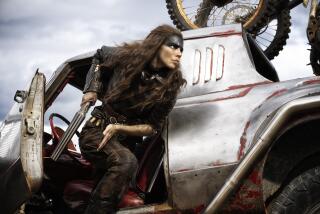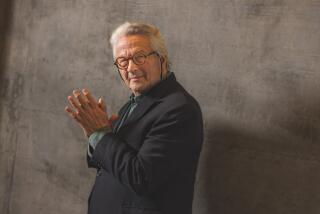MOVIE REVIEW : ‘MAD MAX’ IS FUELED BY ACTION
Far, far past Apocalypse, in humanity’s decay, the twilight of the West, deep in the very bowels of chaos--this is where we find ourselves in George Miller’s “Mad Max: Beyond Thunderdome” (citywide).
Civilization as we knew it is only a memory. The cities have been laid to waste; humanity’s artifacts are charred rubble. Fallout still steams up from the earth. And now here in Australia, this devastated land (which some had thought a refuge from nuclear wars), primitivism has arisen with a vengeance. Tribes of lost, feral children huddle in caves. Nomads wander the parched wastes, soar like vultures in hang gliders or gather in tawdry cities where life is cheap, murder is a spectator sport and energy, in this post-fossil-fuel era, comes from methane gas, extracted by slaves shoveling pig dung.
It’s a hideous world, but it has a hideous energy. It pulses with furious life. Survivors battle tooth and claw in an arena where little of value or beauty is left.
“Beyond Thunderdome” is the third in George Miller’s “Mad Max” series, and it closes the trilogy like a lightning blast followed by the ominous, resonant drone of thunder. Great action sequences crop up frequently today, but great action movies are always few and far between. “Beyond Thunderdome” is one, every bit as much as its two predecessors.
Here, the action is not an end in itself but part of a personal world, ignited by character, streaming up from the rotting milieu. Like John Ford, Howard Hawks or Akira Kurosawa, Miller creates violent set pieces that, as part of an overall vision, keep reverberating in the mind. If the vision seems more garish or simplistic, it’s perhaps because he works in an industry more unsettled and valueless, and in a world teetering on the brink. In a way, he has become chaos’ poet.
He cheerfully violates what has seemed an unbreakable rule of modern sequels, most of which simply repeat the first movie, scene for scene ad nauseam. But Miller goes beyond “The Road Warrior,” amplifies it, creates a logical trilogy . . . though in some ways he retains in all three the original formula: the heroic loner, battling barbaric punks and killers who have taken over the roads.
If in “The Road Warrior” he established himself as the all-time king of the car-chase movie, he lets most of “Thunderdome” go by before breaking out his skills--and then, spectacularly, he breaks new ground. We are 15 years further on, and rickety vehicles streak along like weird insects, remnants of a gaudy, wasteful past.
And if “The Road Warrior” upgraded the art direction and design of “Mad Max I,” in “Beyond Thunderdome” Miller extends himself in another area, ensemble acting--abetted by co-director George Ogilvie, a Melbourne specialist in serious stage drama.
Mel Gibson, who made his debut on screen as Max, still packs the old simmering charisma, but he’s turned the character toward greater weariness, the deadly equipoise of someone who’s danced above hell for too many years--but whose reflexes for heroism (honed in his first incarnation of highway cop defending family) still snap into place at a challenge.
Around him, the acting is no less vivid than before, but more detailed; beyond comic book toward something more Goyaesque.
Tina Turner, the peerless rock singer whom Janis Joplin herself idolized, boils with dynamism. The villainous Auntie Entity, queen of depraved Bartertown, is a perfect role for her: explosive, pungent, bigger than life. She’s backed by a hellishly amusing gallery: Frank Thring (erstwhile all-purpose sneering despot of biblical epics) as Bartertown’s sybaritic “Collector”; Angelo Rossitto and Paul Larsson as the two-headed tyrant Master-Blaster, and, very memorably, Edwin Hodgeman as the despotic auctioneer Dr. Dealgood, hawking bloodshed with the elan of a TV pitchman hawking cars, announcing owlishly to his audience, “Ladies and gentlemen . . . dyin’ time’s here!”
The world of “Beyond Thunderdome” is defined by pop culture--movies, television, comic books, rock ‘n’ roll. But its stature is defined by the way it takes all these elements, tossed into so many movies without any real juice, fire or inspiration, and somehow makes them sing and soar. These battles in the wasteland, wild dances in post-atomic embers, chases through fiery wilds, become a symphony of screams, sighs, shrieks of laughter. The movie is, in every sense of the phrase, outrageously entertaining.
‘MAD MAX: BEYOND THUNDERDOME’ A Warner Bros. distribution of a Kennedy Miller presentation. Producer George Miller. Directors Miller, George Ogilvie. Script Terry Hayes, Miller. Co-producers Doug Mitchell, Hayes. Camera Dean Semler. Music Maurice Jarre. Editor Richard Francis-Bruce. Visual design consultant Ed Verreaux. Costume design Norma Moriceau. Production design Graham Walker. With Mel Gibson, Tina Turner, Frank Thring, Helen Buday, Bruce Spence, Robert Grubb, Angelo Rossitto, Angry Anderson, Edwin Hodgeman.
Running time: 2 hours, 8 minutes.
MPAA-rated: PG-13 (some material may be too intense for children under 13).
More to Read
Only good movies
Get the Indie Focus newsletter, Mark Olsen's weekly guide to the world of cinema.
You may occasionally receive promotional content from the Los Angeles Times.










